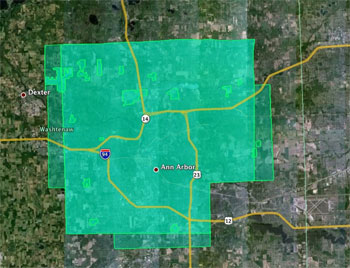Greenbelt Gets Mid-Year Financial Review
Ann Arbor Greenbelt Advisory Commission meeting (Feb. 9, 2011): The main event of the commission’s Wednesday meeting was a review of the second-quarter financial picture. The review was presented by Ginny Trocchio, who works for The Conservation Fund, a consultant the city employs to assist with administering the greenbelt millage. Highlights of the presentation included the calculation of administrative overhead costs – including The Conservation Fund’s work – which are well below the legal maximum of 6%.

Blobs inside the squarish boundaries represent properties or development rights acquired with greenbelt millage funds. The darker squarish area is the original area where millage funds could be spent. The lighter strips to the east, south, and west were added in 2007. (Image links to higher resolution file.)
Though not included explicitly in the millage language, the city approaches the administration of the millage as a one-third/two-thirds split between a portion for parks and a portion for the greenbelt program. So as part of the financial review, commissioners also looked at current fund balances as analyzed based on the one-third/two-third split between parks and greenbelt projects. Noting that the greenbelt fund balance might be on track to be drawn down before the parks portion is exhausted, commissioners seemed to agree that now is a good time to begin mulling what should happen if that scenario played out. The group discussed holding a joint meeting between the park and greenbelt advisory commissions – their last joint session was held in April 2010.
Also discussed on Wednesday was the scheduling of a first meeting of a commission subcommittee that will look at the question of changing greenbelt boundaries. The boundaries define the region where land or development rights on land might be acquired by the greenbelt program. Any change to those boundaries would ultimately require approval from the Ann Arbor city council. [Full Story]



